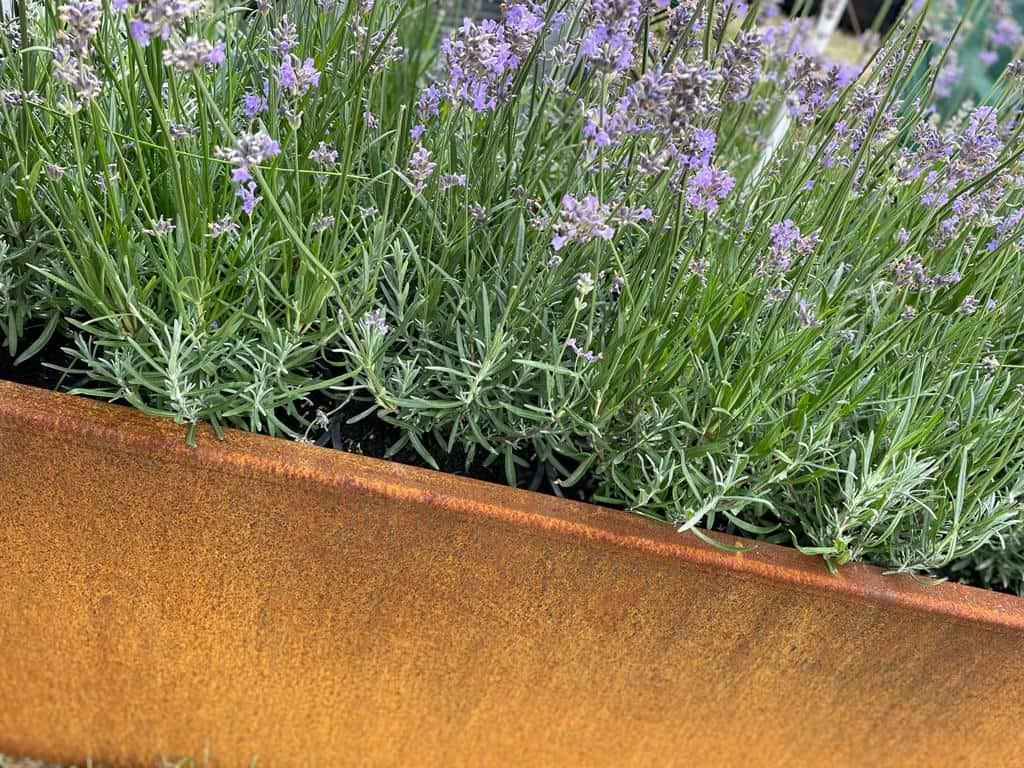Low Maintenance Plant Ideas For Pots And Containers
Low maintenance plant ideas for pots and containers
In this article, we are going to take a look at just a few of the dozens and dozens of plants that are suitable for a low-maintenance display in metal flower pots. Very few plants require absolutely zero maintenance, particularly if you want them to look their best, but there are a surprising number that ask for very little attention over the course of the year.
A general care tip for planting plants that are likely to be in the same place for some time is to add some beneficial mycorrhizal fungi to the root area and planting hole.

Contents
Japanese Maples
We are going to start with a plant that originates from Asia, commonly called the Japanese Maple. This group of relatively small, slow-growing deciduous trees are renowned for their spectacular foliage colour, most notably in autumn. The leaves are often finely lobed and have spectacular colours in reds, oranges, crimsons, and lime greens.
They appreciate a semi-shaded spot to avoid scorching those delicate leaves and require a slightly moister and richer soil or compost than some of the plants we will look at. However, they will require very little in the way of pruning, particularly if you choose cultivars that are naturally smaller such as the bright red-leaved Acer palmatum dissectum ‘Ever Red’ or the green-yellow-leaved Acer shirasawanum ‘Aureum’ that turns orange in autumn.
Obviously, as a tree, they will benefit from a slightly larger and deeper tree planter, although perhaps not as large as you might think for a tree!
Euonymus
This large genus of evergreen or deciduous shrubs that are mainly grown for their foliage are possibly the lowest maintenance of all the plants we will look at and are therefore ideal for commercial outdoor planters. The different species originate from a vast geographic area and comprise mostly easy-to-grow medium-sized shrubs, with some offering ground cover and others able to be clipped into a hedge or standard.
E.europaeus is native to Europe so is fully hardy and is frequently known as the spindle tree. It has dark green leaves, which turn a magnificent scarlet in autumn before falling, and will have spectacular fruit that hold well into winter. It can reach a size of up to 3 metres tall but can also be pruned to keep it smaller and bushier.
E.fortunei ‘Sungold’ is an excellent evergreen shrub with a relatively low-growing mounding habit. It is also remarkably tolerant of shade and serves to really light up a dingy corner with its bright yellow-edged foliage.
Lavender
Lavender are another group of plants consisting of countless cultivars that have been bred over countless years. Most have silver-green foliage, lavender-coloured flowers (although these also come in white and pinks), are extremely drought tolerant, and surprisingly hardy if they are kept out of the worst of the winter wet.
Growing them in pots should help with drainage, particularly if you use a gritty compost or soil mix. They will benefit from an annual clip back in August or September as their flower spikes fade in order to keep them looking bushy and good for a decade before they may need replacing with fresh plants that can easily be taken from cuttings.
‘Munstead’ and ‘Hidcote’ are examples of archetypal English Lavenders (which are actually native to the Mediterranean), while ‘Alba White Grosso’ is a hybrid white-flowered type. There are also dwarf types available, which should grow to around 30cm tall.
The purple of classical lavenders contrasts wonderfully with the burnt orange of our weathered steel planters. A single mature plant in a cube planter may provide a particularly striking look.
Cistus
Another large genus, the rock rose is an attractive bushy evergreen shrub that can grow between 50cm and 2 metres tall and is famed for its papery flowers that are usually white, purple, or pink, and occasionally yellow. It hails from the Mediterranean region, is extremely drought tolerant, and will give a good display for about a decade.
Some of the hardiest types are white-flowered forms like C. laurifolius, C. x hybridus, and C. x cypruis. The latter has prominent burgundy blotches at the base of each petal.
Herbs
Perennial herbs are a great way to give a fragrant, long-lasting display and there are many to choose from.
Rosemary (Salvia rosmarinus syn. Rosmarinus officinalis) is a similar looking plant to lavender, albeit it is a popular culinary herb with small purple-blue flowers and small green leaves.
Chives are in the onion family and have strap-like green leaves that send up spikes with purple globes on top in late spring. They can be trimmed back after flowering.
Mint is an incredibly hardy plant and has distinctive pungent foliage that also comes in a variety of scents and hues. It will spread via underground roots if left and, for that reason, is often grown in a pot in many herb gardens.
Several herbs could be grown together in a series of different sized pots or, alternatively, perhaps in a metal raised bed. A bottomless pot could be sunk into the latter to grow the mint in to restrict its spreading roots.
Erigeron karvinskianus
Otherwise known as Mexican fleabane, this ground-cover perennial has daisy-like flowers in white and pinks and is particularly useful growing near the edge of containers where it may spill over the edges and soften them. It would be ideal for a trough planter or window box on a sunny windowsill or growing as edging in a larger pot. It will die back in winter and originates from parts of Central America but is ideal for a sunny pot in a British garden.
Sempervivums
Often called houseleeks, these evergreen hardy succulents must be grown in a free-draining potting mix to prevent rotting in winter. They actually need remarkably little soil to grow in and can be seen growing in house bricks or forming a part of green rooves. They have small rosettes of leaves that are greens, yellows, or reds in colour. They do flower and send up spikes of flowers in summer.
Hostas
These herbaceous perennials are known for their spectacular foliage and are ideal for a round planter in a shady spot. They are often grown in pots as this provides better protection from their main pests: slugs, which love to chomp on their luscious leaves.
These leaves can be quite large, and are heart-shaped, in a range of colours and patterns including colours such as greens, white, yellows, and turquoises. They also have underappreciated spires of flowers that are mauve or white and borne in summer. They do die back in winter and will benefit from protection in colder winters.
Ferns
These plants are also grown for their foliage and are often associated with shade. The British native Asplenium scolopendrium is often seen growing wild out of stone walls and requires very little maintenance. The Japanese ferns such as Athyrium niponicum have arguably more interesting foliage, often including red and deep purple, and benefit from a slightly damper setting than some ferns such as the Common polypody fern (Polypodium vulgare).
Grasses and sedges
An absolutely enormous range of plants, many of which are suitable for containers. The Pheasant’s Grass (Anemanthele lessoniana) dislikes wet feet and will form clumps of 60-90cm of orange foliage which intensifies in winter. Several types of Carex work well in pots and come in a range of foliage colours, including bronze and variegated green and white.
Miscanthus sinensis, meanwhile, is a larger grass and will form clumps over a metre in height and spread with foliage that wafts in the breeze. Fountain grasses (Pennisteum) form clumps of a similar size to M. sinensis and have fluffy flowers typical of grasses. P. thunbergii ‘Red Buttons’ has a red-purple tinge to its blooms.
Deciduous grasses should have their old foliage removed before the new growth emerges in early spring, while perennial grasses can be ‘combed through’ to remove much of the dead foliage and freshen them up.
